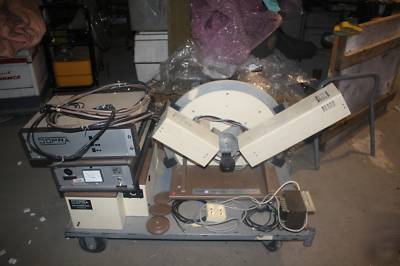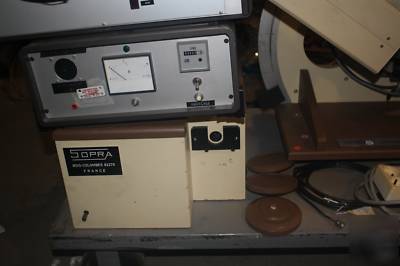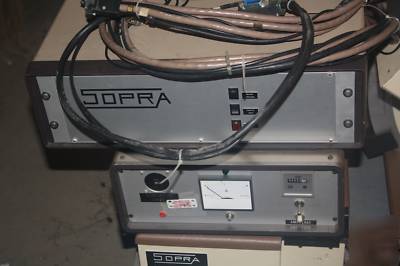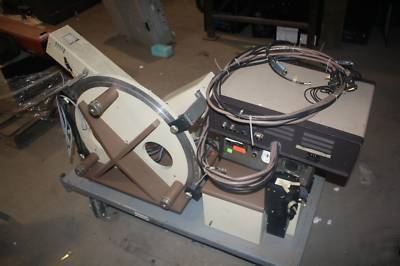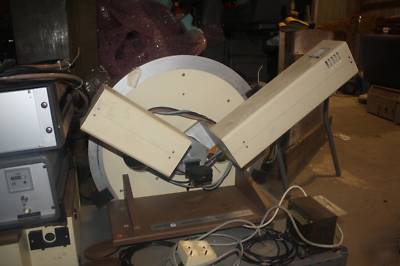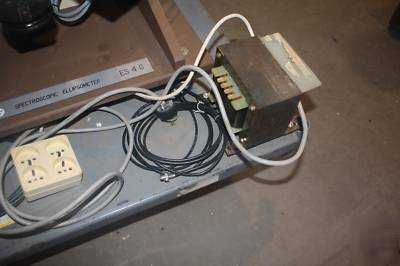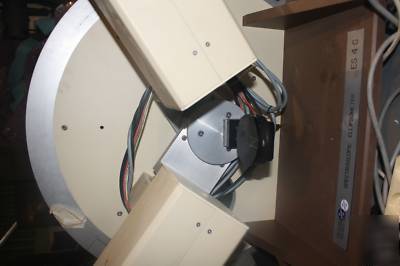____________________ > Ava
> Sopra spectroscopic ellipsometer ES4G nice
Sopra spectroscopic ellipsometer ES4G nice
Sopra ES4G Spectrometer Light Source: Xenon lamp. Intensity drift is < 0.2 % per hour. Polarizer: A quartz ROCHON birefringent beam splitter, usable for a wavelength range of 200 - 2500 nm, rotates at a rate of 40 cycles per second, and its position is tracked with an accuracy of 5.5 x 103 degrees. Sample Stage: Stage height as well as biaxial tilt can be adjusted to give maximum signal, and a pneumatic sample holder holds the sample on the stage Goniometer: The source-polarizer arm and the analyzer arm are mounted on a goniometric support. The angle of incidence may be varied continuously from 45 to 90 degrees with a setting accuracy of 0.01 degrees. Analyzer: A GLAN TAYLOR calcite prism, usable for a spectral range of 200 - 3000 nm, can be rotated by a stepper motor, and its position tracked with an accuracy of 5 x 103 degrees. Spectrometer: A prism/grating system double monochrometer for separating wavelengths with the following features: Two variable slits, adjustable in width from 20 m to 2 mm; the least count of the vernier adjuster is 2 m; an intermediate slit of width 400 m. Spectral range: 230 - 930 nm Resolution at 313 nm = 0.05 nm Dispersion: 31.4 nm/mm, related to grating order Scanning speed maximum of 930 nm/m. Dual monochromators driven by two stepper motors Numeric aperture: f/10; focal length of entrance and exit mirrors = 500 mm Prism made of SiO2, with an angle of 30 Ruled grating features: Number of grooves: 600/mm Ruled area: 52 x 52 mm Blaze wavelength: 2.7 m Blaze angle: 54 6' Monochromatic efficiency: 64 % at 640 nm in the fourth order Specifications Important working characteristics of the ES4G machine are: 1. maximum sample size is 8 inches diameter, 0.5 inch thick. 2. Working spectral range of 275850 nm ( 4.51.5 eV). 3. Dispersion = 0.31.4 nm/mm depending on grating order. 4. Slit width limited resolution (Dl). Completely open slits (W = 2 mm), Dl = 5.6 nm (for dispersion = 1.4nm/mm). Least slit width (W = 20 m), Dl = 0.56 nm (for dispersion = 1.4nm/mm). 5. The photo multiplier tube has been corrected for non-linear effects up to a level of 106 photons reaching the photo cathode in 50 turns of the polarizer. 6. Signal to noise (S/N) ratios for shot noise can be improved by programming the computer to perform an experiment as many as 11 times at a single wavelength and taking the average value of the ellipsometric parameters, S/N ~ n1/2, where n is the number of times the experiment is performed. 7. Measurement time is auto-normalized for each measurement step to a certain number of photons (106) or to a fixed number of rotations of the polarizer (1000), whichever happens first. Resulting variations in the time required to make a full spectral scan may range from < 60 s up to 2.5 h, depending on the number of readings taken at each wavelength, sample characteristics, and the desired accuracy. 8. Angle of incidence can be set with an accuracy of 0.01 .
